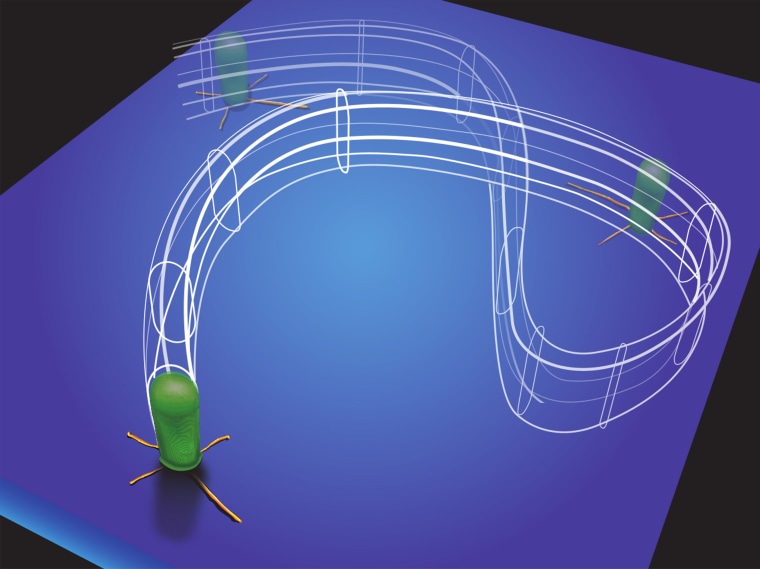Bacteria have legs? That suggestion seemed surprising to Gerard Wong, a bioengineering professor at the University of California at Los Angeles, when his students told him they were seeing some strange behavior in movies of the microbes. "They said, 'You know, we noticed that some of the bacteria — in fact, a lot of them — popped a wheelie and stood up," he recalled. "And I said, 'What are you talking about?'" But in a sense, it's true: The movies show that the Pseudomonas aeruginosa bacteria wiggle themselves up into a vertical position and move leglike projections known as Type IV pili to wander around a surface. Wong and his colleagues describe the phenomenon in this week's issue of the journal Science. You'd think that if bacteria could walk, someone would have noticed it long ago. And it may well have been noticed. But as far as Wong knows, his research team's report is the first systematic set of observations of the behavior. He said that once word got out about the pili phenomenon — for example, at an American Physical Society session in March — he started hearing comments that other researchers were seeing the walking as well. And then came the evolution jokes. "In a way, it's kind of like 'bacteria erectus,'" Wong said. What's next? Opposable thumbs? The funny thing is that Wong's team didn't start out looking for bacteria legs at all. Instead, they were developing an image-processing algorithm to sort through masses of microbe movies, just to check on the effects of the genetic modifications they were making. Pseudomonas aeruginosa is a pathogen that plays a role in cystic fibrosis, and if some genetic twist makes them less able to do their dirty business — which appears to involve forming constrictive biofilms in the lungs — that could suggest new medications for fighting the disease. About 30,000 Americans have cystic fibrosis, and the median life expectancy for people with the genetic disease is about 38 years. The disease isn't caused by bacteria, but it leaves the lungs more vulnerable to infection by bugs such as Pseudomonas aeruginosa. "Once the biofilms form, they become very resistant to antibiotics," Wong said. "At some point there's just absolutely nothing you can do."
Gerard Wong / UCLA Bioengineering, CNSI For directional motion, bacteria generally favor "crawling" in a horizontal orientation, as shown in this schematic.
In addition to reporting the walking behavior, Wong and his colleagues say that there's a link between the prowess of a bacterium's Type IV pili and the ability to form biofilms. The bacteria can use the pili either to walk (in a vertical orientation) or crawl (in a horizontal orientation). Walking seems to be good for wandering around a surface — perhaps to look for food, or to hook up with other bacteria to form a biofilm. Crawling seems to be better for moving directly from one area to another. Wong and other researchers would love to find a way to disrupt the biofilm-forming process. Understanding the behavior of walking bacteria could eventually lead to new treatments, not only for cystic fibrosis, but for other ills related to biofilms. "Failures of implants, dental plaque ... those are all biofilms," Wong said. "Being able to control those biofilms could be very important." So in a sense, Wong's research is aimed at cutting off the legs off harmful bacteria while letting benign microbes go about their business. That goal may be a giant leap for medicine, but there's a benefit to every small scientific step from here to there — including figuring out how bacteria get from here to there. Videos of walking bacteria, courtesy of Gerard Wong:
- Launch sequence: Bacteria attached to a surface can orient themselves perpendicular to the surface. Such "standing" cell orientations play important roles in their life cycles. One example is how bacteria detach from a surface. Here we see that the bacterium spins on the surface, tilts upward to a near-vertical orientation and then launches from the surface.
- Newborn bacterium walks away:After a bacterium divides into two daughter cells, one of the daughter cells stands up, walks away and then detaches from the surface. This new "walking" mechanism, where the bacterium body is upright and perpendicular to the surface, is distinct from the commonly described "crawling" movement, where a bacterium moves while lying down with its body axis parallel to the surface.
- One goes, one stays: After a bacterium divides, one of the daughter cells stands up before detaching from the surface. The other daughter cell remains behind. This difference in cell fates of two sister cells is observed in most division events.
Update for 2:22 p.m. ET: Previous research has found that changing a single calcium-binding site in a Pseudomonas aeruginosa protein molecule can paralyze those Type IV pili — representing one more small step in the fight against cystic fibrosis. Wong is associated with the California NanoSystems Institute at UCLA. Other authors of the Science report, "Bacteria Use Type IV Pili to Walk Upright and Detach from Surfaces," include Maxsim L. Gibiansky, Jacinta C. Conrad, Fan Jin, Vernita D. Gordon, Dominick A. Motto, Margie A. Mathewson, Wiktor G. Stopka, Daria C. Zelasko and Joshua D. Shrout.Visit the brand-spanking-new Cosmic Log page on Facebook and hit the "Like" button. You can also follow @boyle on Twitter. And if you really want to be friendly, ask me about "The Case for Pluto."
